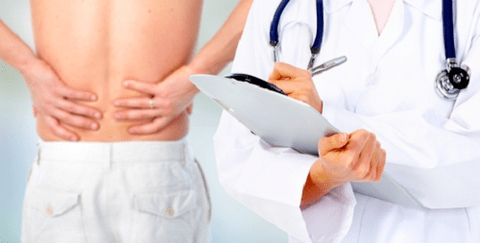Appearing suddenly, acute, painful or dull, radiating to the legs, pain in the lower back, the cause of which cannot always be determined immediately, may indicate the development of various diseases. Only an experienced doctor will be able to understand what exactly caused the pain syndrome, having studied the clinical picture, the patient's complaints, as well as the results of the studies and analysis of ultrasound, X-rays or MRI. But often, even before going to the doctor, the person wants to know in advance what their condition is related to.

The main causes of low back pain
First, all causes of back pain can be divided into two main types:
- Primary (pain is precisely associated with pathology of the spine, intervertebral discs, muscle tissue or joints).
- Secondary (pain occurs with pathologies of internal organs and is given to the lower back, as well as due to infectious diseases in the body, the development of tumors).
Primary Causes of Back Pain
Today, bipedalism is considered the cause of all spinal ailments. The load on the spine increases strongly with the erect position of the body, especially in the lower part - the lower back, which wears out more quickly.
The main causes of back pain are as follows:
- Osteochondrosis of the lumbar spine. Degenerative changes in the spine cause acute pain, inflammation, swelling in the affected area, difficulty in movement. Characteristic changes in the cartilaginous tissue of the vertebral discs and in the vertebral bodies themselves often cause nerve compression, which manifests as acute pain.
- Spondyloarthrosis. This pathology affects the joint tissue in the spinal region. In addition to joint pain, a person with spondyloarthritis may have severe stiffness in movement when it is impossible to straighten or turn.
Low back pain caused by osteochondrosis or spondyloarthrosis requires urgent and immediate medical attention and, of course, prompt treatment.
secondary back pain
A large number of diseases not associated with pathological processes in the spine can cause unpleasant back pain.
There are secondary causes of low back pain, such as:
- spinal curvature (scoliosis, lordosis, etc. );
- infections of various origins affecting the intervertebral discs (tuberculosis, etc. );
- urinary system infections and the consequences of the flu;
- inflammatory processes in the genital area;
- gastrointestinal diseases (appendicitis, pancreatitis, cholecystitis, intestinal colic);
- kidney disease;
- oncological diseases located in the perilumbar region;
- overweight;
- osteoporosis, acute rheumatism, chronic arthritis;
- standing or sitting for an extended period;
- muscle spasm;
- nervous tension, stress.
Diseases of Organs internal organs have their own distinct symptoms, reflected only in the lower back.
Causes low back pain in women and men
The structure of the female body predisposes to the appearance of heaviness and pain in the lower back. This is due to the hormonal context: the menstrual cycle, menopause and pregnancy affect the lower back, as the reproductive organs are located nearby. Gynecological diseases (inflammation of the appendices and uterus) cause radiating low back pain in women.
Likewise, in men, prostatitis and inflammation of the epididymis cause pain. It turns out that men periodically experience back pain during constant work in the cold in a draft, or if the work is associated with weight lifting. These causes of back pain require preventative measures: you need to warm your back and wear a special corset.
muscle tweezers
Separately, I'd like to dwell on moments like muscle spasms, which are often the cause of lower back pain. The constant lack of physical activity leads to the fact that the back muscles are weak and cannot support prolonged or increased loads. Therefore, working on the legs or in an immobile sitting position causes excessive back muscle tension and pain.
Stress has the same effect when muscle tension arises as a result of emotions of fear or anger. This is followed by spasm and pain if not cleared in time.
Concomitant symptoms
Low back pain, whose causes lie in spinal injury, is most often accompanied by the following symptoms:
- discomfort may not only cover the back but also move to the buttocks and lower limbs;
- movement can be very difficult or completely impossible;
- the affected area is usually inflamed and swollen.
For any of these symptoms, you need to seek medical help from a neurologist. If there are other associated symptoms, it is best to contact a therapist who will determine the causes of your back pain and then refer you to a specialist specialist or prescribe treatment.












































